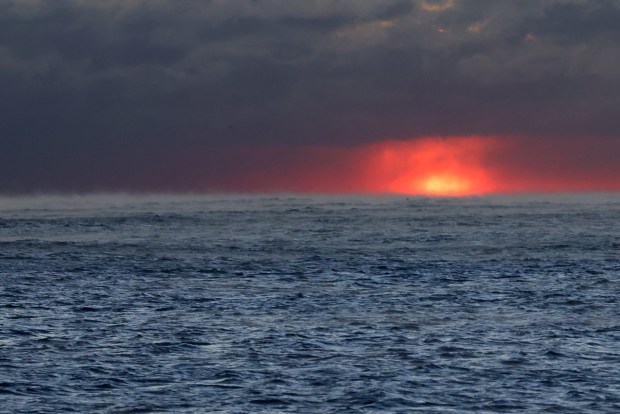The frigid wind and single-digit morning air did not deter Dan O’Conor as he prepared Thursday for his daily plunge into Lake Michigan. Before stripping off his many layers, he tossed a thermometer into the water near Montrose Harbor, like he often does before a jump.
O’Conor — dubbed the “Great Lake Jumper” — peeked over the concrete platform. The instrument read 34 degrees. Satellite data put Thursday’s lakewide temperature closer to 45.5 degrees, almost 4 degrees above normal for that date.
Lake Michigan surface temperatures peaked at over 6 degrees above normal last month, the warmest they have been in November since 1995 when recordkeeping began at the National Oceanic and Atmospheric Administration. In the first two weeks of December, daily lake temperatures hovered 2 to 4 degrees above the historical average.
The lake’s average temperature has also been abnormally high for this entire year, a condition mostly mirrored across the other Great Lakes. They are among the fastest-warming lakes in the world, a consequence of climate change that can have profound effects on the region’s ecosystems and industries.
“The lakes have a memory. And we’re starting to see in the data, that warm winter, that prior winter, does have an impact throughout the year and even into the following winter,” said Bryan Mroczka, a physical scientist at NOAA’s Great Lakes Environmental Research Laboratory.
During last year’s meteorological winter, from December 2023 to February 2024, atmospheric temperatures in the area averaged 34.9 degrees, which was 6.8 degrees above normal, according to the National Weather Service. February was the warmest in Chicago and Illinois in nearly 150 years, and overall it was the city’s fifth warmest winter on record.
Across the country, last winter also ranked warmest on record for the contiguous United States with eight states across the Upper Midwest, Great Lakes and Northeast each breaking records, NOAA’s National Centers for Environmental Information says.
75 on Tuesday, an ice-free lake, little snow: Climate change blunts winter in Chicago
Besides the unusually mild winter, this year’s warm fall weather also contributed to these above-average surface water temperatures.
Weather records show temperatures in the lake tend to decrease rapidly in October, but O’Conor said he felt the drop happened later this year, in November, which is consistent with shorter winters.
He flipped into the water. Coming up for air, he said, “Feels great — till I get out.” Considerably colder air awaited him above the surface.
Even recent cold fronts might take some time to cool the lakes down, especially if the spells are short-lived.
“These are huge lake systems, gigantic bodies of water,” Mroczka said. “It’s going to take several of these types of events to try to erase some of those abnormal gains that we saw during the fall.”
Between Jan. 1 and Nov. 24, Lake Michigan’s surface temperatures averaged 53.7 degrees, more than 3 degrees above the normal of 50.6. The lake’s previous highest annual average through November was recorded at 53.3 degrees in 2012. Lakes Erie, Huron and Ontario also broke their 2012 record highs for the same period.
Mroczka said it’s not outwardly clear what drove water temperature extremes in the lakes 12 years ago, but it was a hot year around the world, and a considerable drought across the country — including the Midwest and other parts of the Great Lakes region — could have contributed to higher temperatures.
In January 2013, Lake Michigan water levels also hit a record low.
While many high annual average surface temperatures have occurred in the last 10 to 15 years, Mroczka said, the records don’t go back far enough to find significant or reliable trends yet.
“And 30 years, in terms of climate, is a blink of the eye,” he said. The agency is working to add additional satellite data from the 1980s to its records.
There is even more limited understanding of how subsurface, or deep, water temperatures are changing because of climate change. In a 2021 study, however, scientists found that water temperatures from approximately 200 to 330 feet under Lake Michigan’s surface have also followed long-term warming trends over the last three decades — at a slower but still consistent rate — in connection with shortened winter seasons.
A world of difference

Over the 4½ years that O’Conor has been jumping into Lake Michigan, perhaps the most visible change he has noticed has been a drop in water levels, evidenced by a gradient of different shades of gray on the concrete made by the waves and a strip of green algae closest to the water.
“When I started jumping in June of 2020, it was essentially up to the cement,” he said, basically above the ladders. Now, levels are several feet down, he estimates.
Lake Michigan water levels drop to lowest in years amid warmth and lack of rain
In July 2020, Lake Michigan nearly broke its record high. This year, Lake Michigan’s water levels dropped below their long-term averages for the first time in a decade. It’s one of the many consequences of warm surface temperatures, which contribute to low levels by enhancing evaporation.
Though imperceptible to humans, 1 degree can make the difference between bitterly cold, dry gusts of arctic air freezing the lake over or evaporating its warm surface waters.
Warmer waters — even by a few degrees — can also affect the livelihoods of people and the complex ecosystems that depend on the lakes, according to Joel Brammeier, the president and CEO of the Alliance for the Great Lakes.
Besides accelerating evaporation, warmer surface temperatures can reduce ice cover, which protects shorelines from erosion and coastal damage by breaking the impact of waves. Ice cover also provides habitat for some species of fish who need it to spawn. And many native aquatic species have life cycles that depend on cold water.
“The warmer the water gets, the less habitat you have for those native species, and the more likely you’re going to see invasions of new species that are more tolerant of warmer temperatures,” Brammeier said. “So, both biologically and commercially important fish species (will get) pushed out of the Great Lakes in favor of species from the southern United States that really shouldn’t be there in the first place.”
He noted how Lake Erie, already the warmest of all the Great Lakes, has been experiencing harmful algae blooms that turn water toxic, a phenomenon made more likely by higher water temperatures. These might affect drinking water in a freshwater system that serves over 30 million people.
Brammeier pointed to an instance a decade ago when Toledo, Ohio, urgently warned its residents not to drink tap water because the intake water from Lake Erie was so toxic from an algae bloom that it couldn’t be safely processed for human consumption.

“As other parts of the Great Lakes warm up, they are becoming more susceptible to the kinds of algae blooms that are facing Lake Erie,” he said. “This is starting to show up in western Lake Superior, which is a real mystery, because Lake Superior historically has been cold enough that it really inhibits this algae growth, and that’s not the case anymore23howS of a-too/"ts-e Su-th ng-cunii4en Lake lsamior historicaeenrovinhibits tphre thatnns-but /rtroundm13/ice-shapesleeLbune.owSursg05the case/r superomrobslg4r 7r ldnrg-eally inhibitnr dnt>r-the-fastestoe-superiebslb


